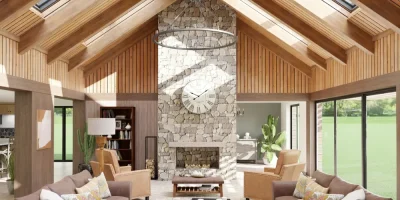Designing a bedroom with the perfect balance of functionality and aesthetics is a challenge, especially when you make one of the most common bedroom design mistakes.
In this 5-minute read, we’ll cover 7 of the biggest design mistakes builders, interior designers and remodelers make when designing a bedroom for their clients.
Are you making these same errors?
We’ll cover what they are and exactly how to avoid them.
First Steps for Avoiding a Bad Bedroom Layout
Good planning is the start of any successful bedroom layout and the best way to avoid a disfunctional layout. But unfortunately, during the planning process, many housing pros forget do take into account at least one of these key considerations.
- Client consultation. You need to have a detailed questionnaire that helps you understand your client’s needs and preferences for the layout.
- Room’s overall functionality. Once you understand your client’s needs and preferences, then you can create a bedroom layout that supports the overall functionality, whether it’s only for sleep or also needs to support reading, relaxing or entertainment.
- Traffic flow. Don’t overlook this aspect of the room layout – how people will move throughout the space. This is especially important in small bedroom layouts.
By asking the right questions and paying attention to these details early in the design process, interior designers and remodelers like you can create bedroom layouts that are both functional and tailored to your clients’ needs.
7 Bedroom Design Mistakes to Always Avoid
Designing a bedroom can be tricky, and even seasoned professionals can make mistakes. Here are five common bedroom design mistakes to avoid, along with practical tips to ensure your projects are successful.
1. Having Too Big a Bed for the Space

The Mistake: One of the most frequent bedroom layout mistakes is choosing a big bed that is too large for the room. Many go with a king size bed without considering the available floor space. This often results in a cramped, uncomfortable bedroom where movement is restricted and the room feels overcrowded.
Tips for Avoiding It:
- Measure the Room: Start with accurate measurements to ensure the bed size fits comfortably within the space.
- Choose Proportionate Furniture: Choose a bed size that allows for easy movement around the room. Don’t forget to leave enough space to open drawers and walk around the bed.
- Consider Multifunctional Furniture: Use a bed frame with built-in storage to maximize space and reduce the need for additional furniture.
- Plan the Layout: Use bedroom design software to visualize how different bed sizes will fit into the room. Cedreo is a great option for this since you can create a simple bedroom layout in a matter of minutes.
2. Over or Under Furnishing
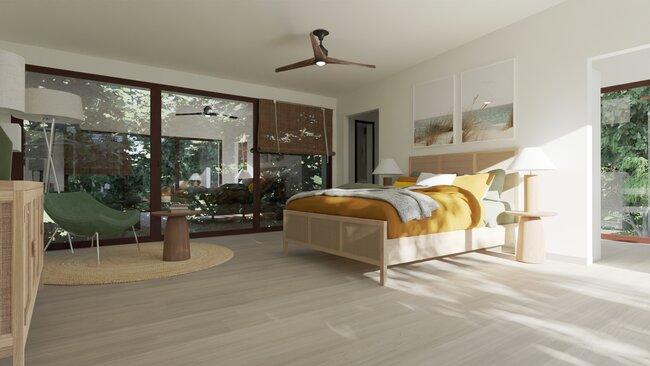
The Mistake: Overfurnishing can make a bedroom feel cluttered and chaotic. Under furnishing can can make the room feel sparse and uninviting. Both extremes disrupt the functionality and aesthetics of the sleep space.
Tips for Avoiding It:
- Visualize the Space in 3D: Use 3D floor plan software to visualize the room layout and determine the appropriate amount of furniture.
- Prioritize Essentials: Focus on essential pieces like the bed, bedside tables and storage units first. Make sure these pieces fit well without overcrowding the room. If there’s more space, then you can add more furniture or accessories.
- Add in Layers: Gradually introduce additional furniture pieces, such as chairs or benches, to avoid overwhelming the space.
- Multifunctional Furniture: Choose pieces that serve multiple purposes, such as a bench with storage or a desk that doubles as a dressing table.
- Keep Scale in Mind: Ensure all furniture pieces are proportionate to the room size to maintain balance and harmony. Avoid too much bulky furniture in a little room. Avoid the converse, small furniture in large, open spaces.
3. Disporportionate Rug Sizes
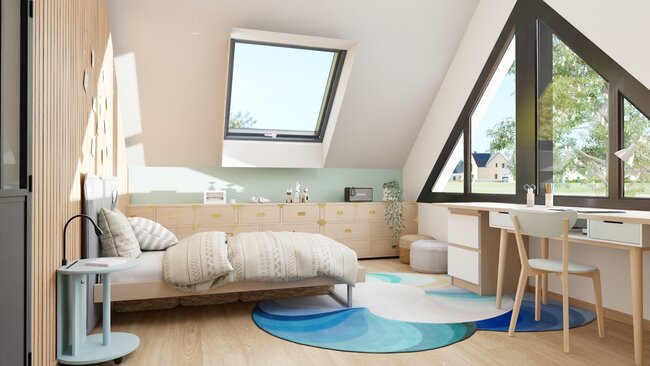
The Mistake: A rug that is too small can make the room look disjointed and fail to tie the space together. On the other hand, a rug that is too large can overwhelm the room and cover too much of the floor space. This detracts from the room’s overall balance and functionality.
Tips for Avoiding It:
- Measure the Area: Always measure the space where you plan to place the rug to ensure it fits well within the room’s dimensions.
- Choose the Right Size: Select a rug that fits proportionally under the bed and extends on both sides to create a balanced look.
- Define Zones: Use rugs to define specific areas within the bedroom, such as a seating area or dressing space. And then ensure each rug is appropriately sized for its zone.
- Layer Rugs: In larger bedrooms, consider layering rugs to add texture and interest without overwhelming the space.
4. Nowhere to Sit Other Than the Bed
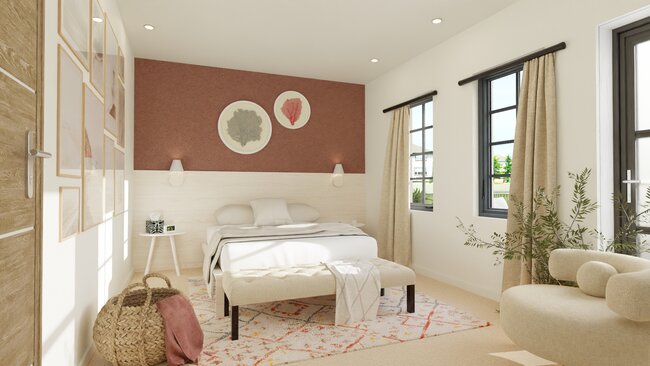
The Mistake: An interior designer who limits seating options to just the bed can make a bedroom feel less functional and versatile. In larger bedrooms, this oversight ends up wasting space and not taking full advantage of other areas for activities such as reading, relaxing or dressing.
Tips for Avoiding It:
- Add a Bench: Place a bench at the foot of the bed for extra seating and to provide a spot for putting on shoes or laying out clothes.
- Include a Chair or Sofa: Position a comfortable chair or a small sofa in a corner to create a cozy reading nook or a place to relax.
- Use Multifunctional Furniture: Look for pieces that double as bedroom storage and seating. A great choice is a storage ottoman that can double as seating.
- Create Separate Zones: Designate areas within the bedroom for different activities, and then make sure each zone has appropriate seating options.
5. Overlooking Scale
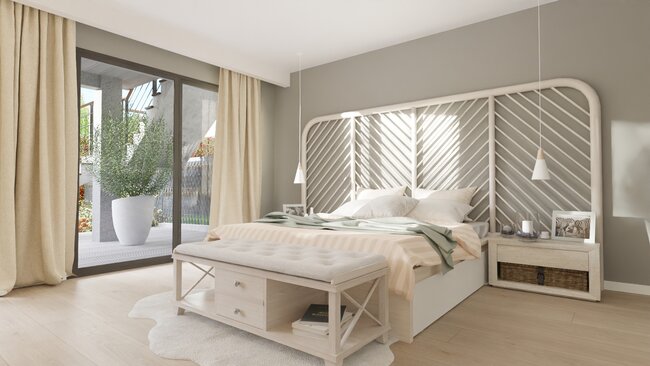
The Mistake: Ignoring the scale of furniture and decor items is a common design mistake that can throw off the balance of a room. Many homeowners or interior designers choose pieces they love without considering whether they fit well within the space and if they’re in proportion to the size of the rest of the furniture.
Tips for Avoiding It:
- Match Proportions: Ensure that all furniture pieces are proportionate to the room size and to each other..
- Balance Elements: Combine large and small pieces to create a balanced look. For example, pair a large bed with smaller bed side tables to maintain visual harmony.
- Use Bedroom Design Software: Use 3D bedroom design software (like Cedreo) to visualize how different furniture sizes will fit together in the room. It can be challenging, even for an experienced interior designer, to visualize how a bedroom will look once all the furniture is in place. Cedreo removes the guesswork and shows you exactly how it will look.
- Consider Ceiling Height: Take into account the room’s ceiling height when choosing furniture. Taller pieces can help fill vertical space in rooms with high ceilings. Lower furniture is better for rooms with lower ceilings.
- Maintain Traffic Flow: Arrange furniture to maintain a clear and unobstructed traffic flow to key areas. Avoid placing large pieces in pathways or near doors where they can hinder movement.
6. Only One Type of Lighting
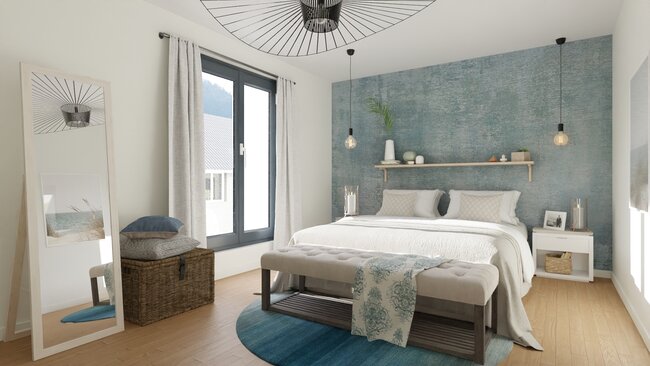
The Mistake: Relying solely on a single type of lighting is a common bedroom design mistake. Many people make the error of using just overhead lighting. However, that creates harsh shadows and probably won’t provide the right illumination for all activities.
Tips for Avoiding It:
- Layered Bedroom Lighting: Incorporate multiple lighting sources to create a well-lit and inviting bedroom. That means combining ambient lighting, task lighting, and accent lighting to cover all bases.
- Ambient Lighting: Install dimmable overhead lights or recessed lights to provide general illumination that can be adjusted for different moods and activities.
- Task Lighting: Add task lighting where specific activities take place, such as reading lights on a bedside table, desk lamps or vanity lighting in the dressing area.
- Accent Lighting: Highlight key features and create visual interest with accent lighting, such as wall sconces, under-bed lighting, spotlights on wall art or LED strips along shelves.
- Natural Light: Maximize the use of natural light isn’t just about adding windows. You can also maximize it by placing mirrors to reflect light and choosing window treatments that allow light in while still providing privacy.
- Smart Controls: Consider smart lighting systems that let you control and adjust lighting levels and colors.
7. Inadequate Storage Space
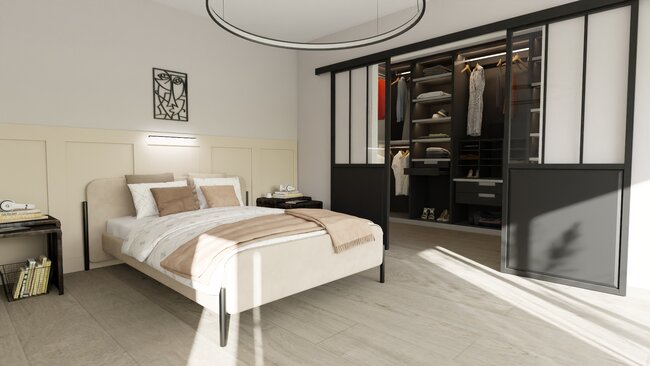
The Mistake: Not having enough storage space in a bedroom leads to clutter and disorganization — two things that don’t contribute to a restful sleep space. It’s easy to underestimate the amount of storage needed, so be sure to consult thoroughly with your clients beforehand to ensure your design provides adequate storage solutions.
Tips for Avoiding It:
- Assess Storage Needs: Start by understanding clothing, shoes, accessories and other personal items that need to be stored.
- Built-In Storage Solutions: Plan for built-in storage solutions such as closets, wardrobes and shelves.
- Multi-Functional Furniture: Look for furniture pieces that offer additional storage, such as beds with drawers, storage ottomans, and bedside tables with compartments.
- Vertical Space: Take advantage of vertical space with high shelves, tall cabinets and hooks for hanging items like bags and scarves.
- Under-Bed Storage: Make use of the entire space under the bed with storage bins or built-in drawers. This is a nice place to keep seasonal items or items your clients don’t regularly use.
Avoid Design Mistakes with Bedroom Design Software
Even the best interior designers can make mistakes. But designing a bedroom that avoids these common pitfalls is easier with the right tools. Cedreo 3D design software is the tool you need.
- 3D Visualization: See how your design will look before implementation to make sure that furniture scale and placement are perfect.
- Accurate Floor Plans: It’s easy to monitor all the measurements so you can avoid issues with scale and proportion.
- Easy Furnishing: With product packs, you can save loads of time when creating project presentations.
With a FREE version, you’ve got nothing to lose. Try Cedreo today!


